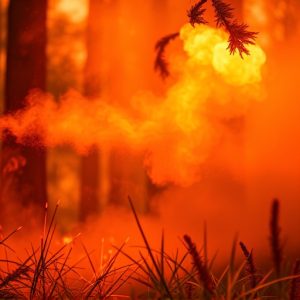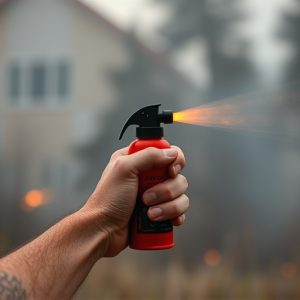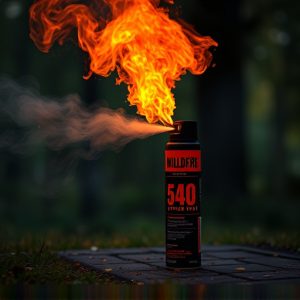Guarding Against Threats: A Guide to Using Wildfire Pepper Spray for Personal Defense
The Wildfire pepper spray is a high-strength self-defense tool containing a potent concentration of…….
The Wildfire pepper spray is a high-strength self-defense tool containing a potent concentration of oleoresin capsicum, which causes an intense and rapid inflammatory response upon contact with an assailant. This reaction leads to immediate pain, swelling, and vision impairment in the eyes, effectively deterring attackers. Its advanced stream delivery system allows for a longer effective range, keeping you at a safe distance from threats. For optimal performance, understanding its use is essential, as environmental factors can impact its effectiveness. Regular maintenance ensures the spray functions correctly. The Wildfire pepper spray is a dependable self-defense mechanism, with a formulation strong enough to deter aggressors while causing minimal lasting harm. It's designed for personal protection, offering a high-strength capsaicinoid formulation and strategic delivery system. Remember to familiarize yourself with local regulations on its use, practice with the spray to ensure confidence in deployment, and be prepared for the temporary effects that subside within 30 to 45 minutes when medical care is received. For those seeking protection against wildfire threats, this pepper spray is a valuable tool when used as part of a comprehensive safety strategy, which includes evacuation planning, staying informed on local fire conditions, and adhering to official guidance during wildfires. Ensure you consider the concentration of OC (at least 10%), the efficiency of the delivery system, the legality in your area, and maintain the spray for consistent reliability in self-defense situations.
When considering personal protection measures, the topic of wildfire pepper spray emerges as a significant discussion point. This article delves into the multifaceted aspects of wildfire pepper spray, offering readers a thorough understanding through its guided sections. From its scientific makeup to its practical application and selection based on individual needs, this piece aims to empower readers with knowledge about this potent self-defense tool. Engage with us as we dissect the components, efficacy, and safety considerations surrounding wildfire pepper spray—your shield against potential harm.
Understanding Wildfire Pepper Spray: A Comprehensive Guide
Wildfire pepper spray stands as a formidable personal protection tool, designed to incapacitate an assailant with its potent formula. Unlike traditional pepper sprays, Wildfire brand infuses its product with a high concentration of oleoresin capsicum, which is the active ingredient responsible for inducing an intense inflammatory response upon contact. This causes immediate eye pain, swelling, and impaired vision within seconds, effectively disorienting and deterring an attacker. The unique formula is encased in a powerful stream delivery system, allowing for a longer range than most pepper sprays, which can be crucial in maintaining a safe distance from a threat.
When considering the integration of Wildfire pepper spray into your personal protection plan, it’s imperative to understand its mechanisms, limitations, and proper usage. It’s not just about having the tool; knowing how to deploy it effectively under pressure is equally important. The spray’s effectiveness can be compromised by environmental factors such as wind or precipitation, so users must familiarize themselves with its performance in various conditions. Training with the spray can enhance one’s proficiency and ensure that when faced with an aggressive confrontation, Wildfire pepper spray can serve as a reliable deterrent. Regular maintenance of the spray, including checking its expiration date and pressure levels, is also vital for its dependable operation. With its high-strength formulation and strategic design, Wildfire pepper spray emerges as a robust addition to any personal safety arsenal.
The Science Behind the Heat: How Wildfire Pepper Spray Works
Wildfire pepper spray is a form of self-defense that harnesses the potent effects of capsaicinoids, derived from chili peppers. Capsaicinoids are the active ingredients responsible for the intense heat associated with peppers and, in the context of self-defense sprays, can incapacitate an attacker. Upon deployment, the spray’s fine particles are propelled towards an assailant, penetrating their eyes, respiratory system, and skin. Once contacted, the capsaicinoids interact with sensory neurons that transmit pain signals to the brain, causing a debilitating burning sensation which can lead to immediate and temporary blindness, difficulty in breathing, and significant discomfort. This overwhelming reaction buys valuable time for the user to escape or seek help, as the effects typically subside within 30 to 45 minutes post-exposure, provided medical attention is received promptly. The formulation of Wildfire pepper spray is specifically designed to be highly effective in deterring potential aggressors while minimizing the risk of long-term harm. It’s a non-lethal tool that leverages the science behind its active ingredients to provide personal protection against physical threats.
Effective Usage and Safety Measures with Wildfire Pepper Spray
When utilizing wildfire pepper spray for personal protection against wildfire threats, effective usage hinges on understanding its properties and limitations. This powerful self-defense tool can incapacitate an aggressor by inducing intense pain and inflammation in their eyes and respiratory system. To ensure safety and efficacy, it’s crucial to familiarize oneself with the product prior to any encounter. Keep the spray directed away from your face and body, as accidental exposure can cause severe irritation. Practice deploying the spray under controlled conditions to confidently use it when necessary. Always adhere to local regulations regarding pepper spray usage; some areas may have specific guidelines or restrictions in place. In the event of an accidental discharge indoors, ventilate the area immediately and seek medical attention if symptoms persist. It’s also advisable to pair wildfire pepper spray with other wildfire safety measures, such as having an evacuation plan ready, staying informed about local fire conditions, and heeding all official warnings or orders. Proper usage and preparation can significantly enhance personal protection during the unpredictable nature of wildfire events.
Choosing the Right Wildfire Pepper Spray for Your Personal Protection Needs
When considering wildfire pepper spray for personal protection, it’s crucial to evaluate several key factors to ensure effectiveness and suitability for your specific needs. Firstly, the concentration of the active ingredient, oleoresin capsicum (OC), is a primary consideration. Higher concentrations typically offer greater stopping power, with formulations ranging from 5% to 20% OC. A canister with a minimum of 10% OC is generally recommended for self-defense purposes. Additionally, the spray’s delivery mechanism should be reliable and user-friendly. Look for models that provide a concentrated stream capable of reaching up to 20 feet, which can create a protective barrier between you and an assailant.
Another important aspect is the spray’s key ingredient’s strength. A high-strength formula will cause intense irritation upon contact, deterring attackers more effectively. It’s also essential to consider the canister’s size and shape for ease of carrying. Some models come in discreet, pocket-sized containers, while others are designed with a keychain hole for easy access. Furthermore, ensure the spray is legal in your jurisdiction, as pepper spray laws vary by state and country. Lastly, practice using your chosen wildfire pepper spray to familiarize yourself with its operation and to build confidence in its deployment during an emergency situation. Regular maintenance of the canister, such as checking for blockages and ensuring the safety lock functions correctly, will also help guarantee the spray is ready when needed.


